Assessing the Impact of Vehicle Speed Limits and Fleet Composition on Air Quality Near a School
Abstract
1. Introduction
2. Research Methodology
2.1. Model Development
2.1.1. Traffic Model
2.1.2. Dispersion and Emission Model
2.2. Scenarios
3. Modelling Results
3.1. The Traffic Model
3.1.1. Volumes and Speeds
3.1.2. Result of Validation for Traffic Volumes
3.2. Dispersion Model Validation
3.3. The Effect of Speed Limit Changes
3.4. The Effect of Fleet Composition
4. Discussion
5. Conclusions
Author Contributions
Funding
Acknowledgments
Conflicts of Interest
Appendix A
| Sector | Subsector | Technology | Vehicle # in 2013 |
|---|---|---|---|
| Passenger Cars | Gasoline 0.8–1.4 l | PRE ECE | 0 |
| Passenger Cars | Gasoline 0.8–1.4 l | ECE 15/00-01 | 0 |
| Passenger Cars | Gasoline 0.8–1.4 l | ECE 15/02 | 0 |
| Passenger Cars | Gasoline 0.8–1.4 l | ECE 15/03 | 0 |
| Passenger Cars | Gasoline 0.8–1.4 l | ECE 15/04 | 949 |
| Passenger Cars | Gasoline 0.8–1.4 l | Open Loop | 0 |
| Passenger Cars | Gasoline 0.8–1.4 l | PC Euro 1–91/441/EEC | 7739 |
| Passenger Cars | Gasoline 0.8–1.4 l | PC Euro 2–94/12/EEC | 201,061 |
| Passenger Cars | Gasoline 0.8–1.4 l | PC Euro 3–98/69/EC Stage2000 | 276,634 |
| Passenger Cars | Gasoline 0.8–1.4 l | PC Euro 4–98/69/EC Stage2005 | 251,944 |
| Passenger Cars | Gasoline 0.8–1.4 l | PC Euro 5–EC 715/2007 | 39,297 |
| Passenger Cars | Gasoline 0.8–1.4 l | PC Euro 6–EC 715/2007 | 0 |
| Passenger Cars | Gasoline 1.4–2.0 l | PRE ECE | 0 |
| Passenger Cars | Gasoline 1.4–2.0 l | ECE 15/00-01 | 0 |
| Passenger Cars | Gasoline 1.4–2.0 l | ECE 15/02 | 0 |
| Passenger Cars | Gasoline 1.4–2.0 l | ECE 15/03 | 0 |
| Passenger Cars | Gasoline 1.4–2.0 l | ECE 15/04 | 504 |
| Passenger Cars | Gasoline 1.4–2.0 l | Open Loop | 0 |
| Passenger Cars | Gasoline 1.4–2.0 l | PC Euro 1–91/441/EEC | 4434 |
| Passenger Cars | Gasoline 1.4–2.0 l | PC Euro 2–94/12/EEC | 106,786 |
| Passenger Cars | Gasoline 1.4–2.0 l | PC Euro 3–98/69/EC Stage2000 | 146,907 |
| Passenger Cars | Gasoline 1.4–2.0 l | PC Euro 4–98/69/EC Stage2005 | 136,307 |
| Passenger Cars | Gasoline 1.4–2.0 l | PC Euro 5–EC 715/2007 | 21,812 |
| Passenger Cars | Gasoline 1.4–2.0 l | PC Euro 6–EC 715/2007 | 0 |
| Passenger Cars | Gasoline > 2.0 l | PRE ECE | 0 |
| Passenger Cars | Gasoline > 2.0 l | ECE 15/00-01 | 0 |
| Passenger Cars | Gasoline > 2.0 l | ECE 15/02 | 0 |
| Passenger Cars | Gasoline > 2.0 l | ECE 15/03 | 0 |
| Passenger Cars | Gasoline > 2.0 l | ECE 15/04 | 33 |
| Passenger Cars | Gasoline > 2.0 l | PC Euro 1–91/441/EEC | 425 |
| Passenger Cars | Gasoline > 2.0 l | PC Euro 2–94/12/EEC | 7055 |
| Passenger Cars | Gasoline > 2.0 l | PC Euro 3–98/69/EC Stage2000 | 9699 |
| Passenger Cars | Gasoline > 2.0 l | PC Euro 4–98/69/EC Stage2005 | 9733 |
| Passenger Cars | Gasoline > 2.0 l | PC Euro 5–EC 715/2007 | 1723 |
| Passenger Cars | Gasoline > 2.0 l | PC Euro 6–EC 715/2007 | 0 |
| Passenger Cars | Diesel 1.4–2.0 l | Conventional | 182 |
| Passenger Cars | Diesel 1.4–2.0 l | PC Euro 1–91/441/EEC | 1452 |
| Passenger Cars | Diesel 1.4–2.0 l | PC Euro 2–94/12/EEC | 38,544 |
| Passenger Cars | Diesel 1.4–2.0 l | PC Euro 3–98/69/EC Stage2000 | 132,268 |
| Passenger Cars | Diesel 1.4–2.0 l | PC Euro 4–98/69/EC Stage2005 | 288,016 |
| Passenger Cars | Diesel 1.4–2.0 l | PC Euro 5–EC 715/2007 | 160,045 |
| Passenger Cars | Diesel 1.4–2.0 l | PC Euro 6–EC 715/2007 | 0 |
| Passenger Cars | Diesel > 2.0 l | Conventional | 26 |
| Passenger Cars | Diesel > 2.0 l | PC Euro 1–91/441/EEC | 209 |
| Passenger Cars | Diesel > 2.0 l | PC Euro 2–94/12/EEC | 5545 |
| Passenger Cars | Diesel > 2.0 l | PC Euro 3–98/69/EC Stage2000 | 19,029 |
| Passenger Cars | Diesel > 2.0 l | PC Euro 4–98/69/EC Stage2005 | 41,435 |
| Passenger Cars | Diesel > 2.0 l | PC Euro 5–EC 715/2007 | 23,025 |
| Passenger Cars | Diesel > 2.0 l | PC Euro 6–EC 715/2007 | 0 |
| Passenger Cars | LPG | Conventional | 0 |
| Passenger Cars | LPG | PC Euro 1–91/441/EEC | 72 |
| Passenger Cars | LPG | PC Euro 2–94/12/EEC | 57 |
| Passenger Cars | LPG | PC Euro 3–98/69/EC Stage2000 | 57 |
| Passenger Cars | LPG | PC Euro 4–98/69/EC Stage2005 | 57 |
| Passenger Cars | LPG | PC Euro 5–EC 715/2007 | 0 |
| Passenger Cars | LPG | PC Euro 6–EC 715/2007 | 0 |
| Passenger Cars | Hybrid Gasoline < 1.4 l | PC Euro 4–98/69/EC Stage2005 | 0 |
| Passenger Cars | Hybrid Gasoline 1.4–2.0 l | PC Euro 4–98/69/EC Stage2005 | 0 |
| Passenger Cars | Hybrid Gasoline > 2.0 l | PC Euro 4–98/69/EC Stage2005 | 0 |
| Light Commercial Vehicles | Gasoline < 3.5 t | Conventional | 4 |
| Light Commercial Vehicles | Gasoline < 3.5 t | LD Euro 1–93/59/EEC | 28 |
| Light Commercial Vehicles | Gasoline < 3.5 t | LD Euro 2–96/69/EEC | 101 |
| Light Commercial Vehicles | Gasoline < 3.5 t | LD Euro 3–98/69/EC Stage2000 | 236 |
| Light Commercial Vehicles | Gasoline < 3.5 t | LD Euro 4–98/69/EC Stage2005 | 292 |
| Light Commercial Vehicles | Gasoline < 3.5 t | LD Euro 5–2008 Standards | 78 |
| Light Commercial Vehicles | Gasoline < 3.5 t | LD Euro 6 | 0 |
| Light Commercial Vehicles | Diesel < 3.5 t | Conventional | 1441 |
| Light Commercial Vehicles | Diesel < 3.5 t | LD Euro 1–93/59/EEC | 10,951 |
| Light Commercial Vehicles | Diesel < 3.5 t | LD Euro 2–96/69/EEC | 39,482 |
| Light Commercial Vehicles | Diesel < 3.5 t | LD Euro 3–98/69/EC Stage2000 | 92,220 |
| Light Commercial Vehicles | Diesel < 3.5 t | LD Euro 4–98/69/EC Stage2005 | 113,834 |
| Light Commercial Vehicles | Diesel < 3.5 t | LD Euro 5–2008 Standards | 30,260 |
| Light Commercial Vehicles | Diesel < 3.5 t | LD Euro 6 | 0 |
| Heavy Duty Trucks | Gasoline >3.5 t | Conventional | 24 |
| Heavy Duty Trucks | Rigid ≤ 7.5 t | Conventional | 108 |
| Heavy Duty Trucks | Rigid <= 7.5 t | HD Euro I–91/542/EEC Stage I | 287 |
| Heavy Duty Trucks | Rigid <= 7.5 t | HD Euro II–91/542/EEC Stage II | 1228 |
| Heavy Duty Trucks | Rigid <= 7.5 t | HD Euro III–2000 Standards | 2868 |
| Heavy Duty Trucks | Rigid <= 7.5 t | HD Euro IV–2005 Standards | 3541 |
| Heavy Duty Trucks | Rigid <= 7.5 t | HD Euro V–2008 Standards | 932 |
| Heavy Duty Trucks | Rigid <= 7.5 t | HD Euro VI | 0 |
| Heavy Duty Trucks | Rigid 7.5–12 t | Conventional | 129 |
| Heavy Duty Trucks | Rigid 7.5–12 t | HD Euro I–91/542/EEC Stage I | 345 |
| Heavy Duty Trucks | Rigid 7.5–12 t | HD Euro II–91/542/EEC Stage II | 1477 |
| Heavy Duty Trucks | Rigid 7.5–12 t | HD Euro III–2000 Standards | 3450 |
| Heavy Duty Trucks | Rigid 7.5–12 t | HD Euro IV–2005 Standards | 4258 |
| Heavy Duty Trucks | Rigid 7.5–12 t | HD Euro V–2008 Standards | 1121 |
| Heavy Duty Trucks | Rigid 7.5–12 t | HD Euro VI | 0 |
| Heavy Duty Trucks | Rigid 12–14 t | Conventional | 66 |
| Heavy Duty Trucks | Rigid 12–14 t | HD Euro I–91/542/EEC Stage I | 176 |
| Heavy Duty Trucks | Rigid 12–14 t | HD Euro II–91/542/EEC Stage II | 754 |
| Heavy Duty Trucks | Rigid 12–14 t | HD Euro III–2000 Standards | 1761 |
| Heavy Duty Trucks | Rigid 12–14 t | HD Euro IV–2005 Standards | 2173 |
| Heavy Duty Trucks | Rigid 12–14 t | HD Euro V–2008 Standards | 572 |
| Heavy Duty Trucks | Rigid 12–14 t | HD Euro VI | 0 |
| Heavy Duty Trucks | Rigid 14–20 t | Conventional | 43 |
| Heavy Duty Trucks | Rigid 14–20 t | HD Euro I–91/542/EEC Stage I | 114 |
| Heavy Duty Trucks | Rigid 14–20 t | HD Euro II–91/542/EEC Stage II | 487 |
| Heavy Duty Trucks | Rigid 14–20 t | HD Euro III–2000 Standards | 1137 |
| Heavy Duty Trucks | Rigid 14–20 t | HD Euro IV–2005 Standards | 1403 |
| Heavy Duty Trucks | Rigid 14–20 t | HD Euro V–2008 Standards | 370 |
| Heavy Duty Trucks | Rigid 14–20 t | HD Euro VI | 0 |
| Heavy Duty Trucks | Rigid 20–26 t | Conventional | 0 |
| Heavy Duty Trucks | Rigid 20–26 t | HD Euro I–91/542/EEC Stage I | 0 |
| Heavy Duty Trucks | Rigid 20–26 t | HD Euro II–91/542/EEC Stage II | 1 |
| Heavy Duty Trucks | Rigid 20–26 t | HD Euro III–2000 Standards | 3 |
| Heavy Duty Trucks | Rigid 20–26 t | HD Euro IV–2005 Standards | 4 |
| Heavy Duty Trucks | Rigid 20–26 t | HD Euro V–2008 Standards | 1 |
| Heavy Duty Trucks | Rigid 20–26 t | HD Euro VI | 0 |
| Heavy Duty Trucks | Rigid 26–28 t | Conventional | 0 |
| Heavy Duty Trucks | Rigid 26–28 t | HD Euro I–91/542/EEC Stage I | 0 |
| Heavy Duty Trucks | Rigid 26–28 t | HD Euro II–91/542/EEC Stage II | 1 |
| Heavy Duty Trucks | Rigid 26–28 t | HD Euro III–2000 Standards | 3 |
| Heavy Duty Trucks | Rigid 26–28 t | HD Euro IV–2005 Standards | 4 |
| Heavy Duty Trucks | Rigid 26–28 t | HD Euro V–2008 Standards | 1 |
| Heavy Duty Trucks | Rigid 26–28 t | HD Euro VI | 0 |
| Heavy Duty Trucks | Rigid 28–32 t | Conventional | 0 |
| Heavy Duty Trucks | Rigid 28–32 t | HD Euro I–91/542/EEC Stage I | 0 |
| Heavy Duty Trucks | Rigid 28–32 t | HD Euro II–91/542/EEC Stage II | 1 |
| Heavy Duty Trucks | Rigid 28–32 t | HD Euro III–2000 Standards | 3 |
| Heavy Duty Trucks | Rigid 28–32 t | HD Euro IV–2005 Standards | 4 |
| Heavy Duty Trucks | Rigid 28–32 t | HD Euro V–2008 Standards | 1 |
| Heavy Duty Trucks | Rigid 28–32 t | HD Euro VI | 0 |
| Heavy Duty Trucks | Rigid > 32 t | Conventional | 0 |
| Heavy Duty Trucks | Rigid > 32 t | HD Euro I–91/542/EEC Stage I | 0 |
| Heavy Duty Trucks | Rigid > 32 t | HD Euro II–91/542/EEC Stage II | 1 |
| Heavy Duty Trucks | Rigid > 32 t | HD Euro III–2000 Standards | 3 |
| Heavy Duty Trucks | Rigid > 32 t | HD Euro IV–2005 Standards | 4 |
| Heavy Duty Trucks | Rigid > 32 t | HD Euro V–2008 Standards | 1 |
| Heavy Duty Trucks | Rigid > 32 t | HD Euro VI | 0 |
| Heavy Duty Trucks | Articulated 40–50 t | Conventional | 0 |
| Heavy Duty Trucks | Articulated 40–50 t | HD Euro I–91/542/EEC Stage I | 0 |
| Heavy Duty Trucks | Articulated 40–50 t | HD Euro II–91/542/EEC Stage II | 1 |
| Heavy Duty Trucks | Articulated 40–50 t | HD Euro III–2000 Standards | 3 |
| Heavy Duty Trucks | Articulated 40–50 t | HD Euro IV–2005 Standards | 4 |
| Heavy Duty Trucks | Articulated 40–50 t | HD Euro V–2008 Standards | 1 |
| Heavy Duty Trucks | Articulated 40–50 t | HD Euro VI | 0 |
| Heavy Duty Trucks | Articulated 50–60 t | Conventional | 0 |
| Heavy Duty Trucks | Articulated 50–60 t | HD Euro I–91/542/EEC Stage I | 0 |
| Heavy Duty Trucks | Articulated 50–60 t | HD Euro II–91/542/EEC Stage II | 1 |
| Heavy Duty Trucks | Articulated 50–60 t | HD Euro III–2000 Standards | 3 |
| Heavy Duty Trucks | Articulated 50–60 t | HD Euro IV–2005 Standards | 4 |
| Heavy Duty Trucks | Articulated 50–60 t | HD Euro V–2008 Standards | 1 |
| Heavy Duty Trucks | Articulated 50–60 t | HD Euro VI | 0 |
| Buses | Urban Buses Standard 15–18 t | Conventional | 273 |
| Buses | Urban Buses Standard 15–18 t | HD Euro I–91/542/EEC Stage I | 190 |
| Buses | Urban Buses Standard 15–18 t | HD Euro II–91/542/EEC Stage II | 752 |
| Buses | Urban Buses Standard 15–18 t | HD Euro III–2000 Standards | 849 |
| Buses | Urban Buses Standard 15–18 t | HD Euro IV–2005 Standards | 596 |
| Buses | Urban Buses Standard 15–18 t | HD Euro V–2008 Standards | 369 |
| Buses | Urban Buses Standard 15–18 t | HD Euro VI | 0 |
| Buses | Coaches Standard <= 18 t | Conventional | 639 |
| Buses | Coaches Standard <= 18 t | HD Euro I–91/542/EEC Stage I | 445 |
| Buses | Coaches Standard <= 18 t | HD Euro II–91/542/EEC Stage II | 1765 |
| Buses | Coaches Standard <= 18 t | HD Euro III–2000 Standards | 1990 |
| Buses | Coaches Standard <= 18 t | HD Euro IV–2005 Standards | 1397 |
| Buses | Coaches Standard <= 18 t | HD Euro V–2008 Standards | 866 |
| Buses | Coaches Standard <= 18 t | HD Euro VI | 0 |
| Mopeds | 2-stroke < 50 cm3 | Conventional | 188 |
| Mopeds | 2-stroke < 50 cm3 | Mop–Euro I | 296 |
| Mopeds | 2-stroke < 50 cm3 | Mop–Euro II | 161 |
| Mopeds | 2-stroke < 50 cm3 | Mop–Euro III | 251 |
| Mopeds | 4-stroke < 50 cm3 | Conventional | 188 |
| Mopeds | 4-stroke < 50 cm3 | Mop–Euro I | 295 |
| Mopeds | 4-stroke < 50 cm3 | Mop–Euro II | 161 |
| Mopeds | 4-stroke < 50 cm3 | Mop–Euro III | 251 |
| Motorcycles | 2-stroke > 50 cm3 | Conventional | 3329 |
| Motorcycles | 4-stroke < 250 cm3 | Conventional | 699 |
| Motorcycles | 4-stroke < 250 cm3 | Mot–Euro I | 1099 |
| Motorcycles | 4-stroke < 250 cm3 | Mot–Euro II | 599 |
| Motorcycles | 4-stroke < 250 cm3 | Mot–Euro III | 932 |
| Motorcycles | 4-stroke 250–750 cm3 | Conventional | 5325 |
| Motorcycles | 4-stroke 250–750 cm3 | Mot–Euro I | 8368 |
| Motorcycles | 4-stroke 250–750 cm3 | Mot–Euro II | 4564 |
| Motorcycles | 4-stroke 250–750 cm3 | Mot–Euro III | 7100 |
| Motorcycles | 4-stroke > 750 cm3 | Conventional | 592 |
| Motorcycles | 4-stroke > 750 cm3 | Mot–Euro I | 930 |
| Motorcycles | 4-stroke > 750 cm3 | Mot–Euro II | 507 |
| Motorcycles | 4-stroke > 750 cm3 | Mot–Euro III | 789 |
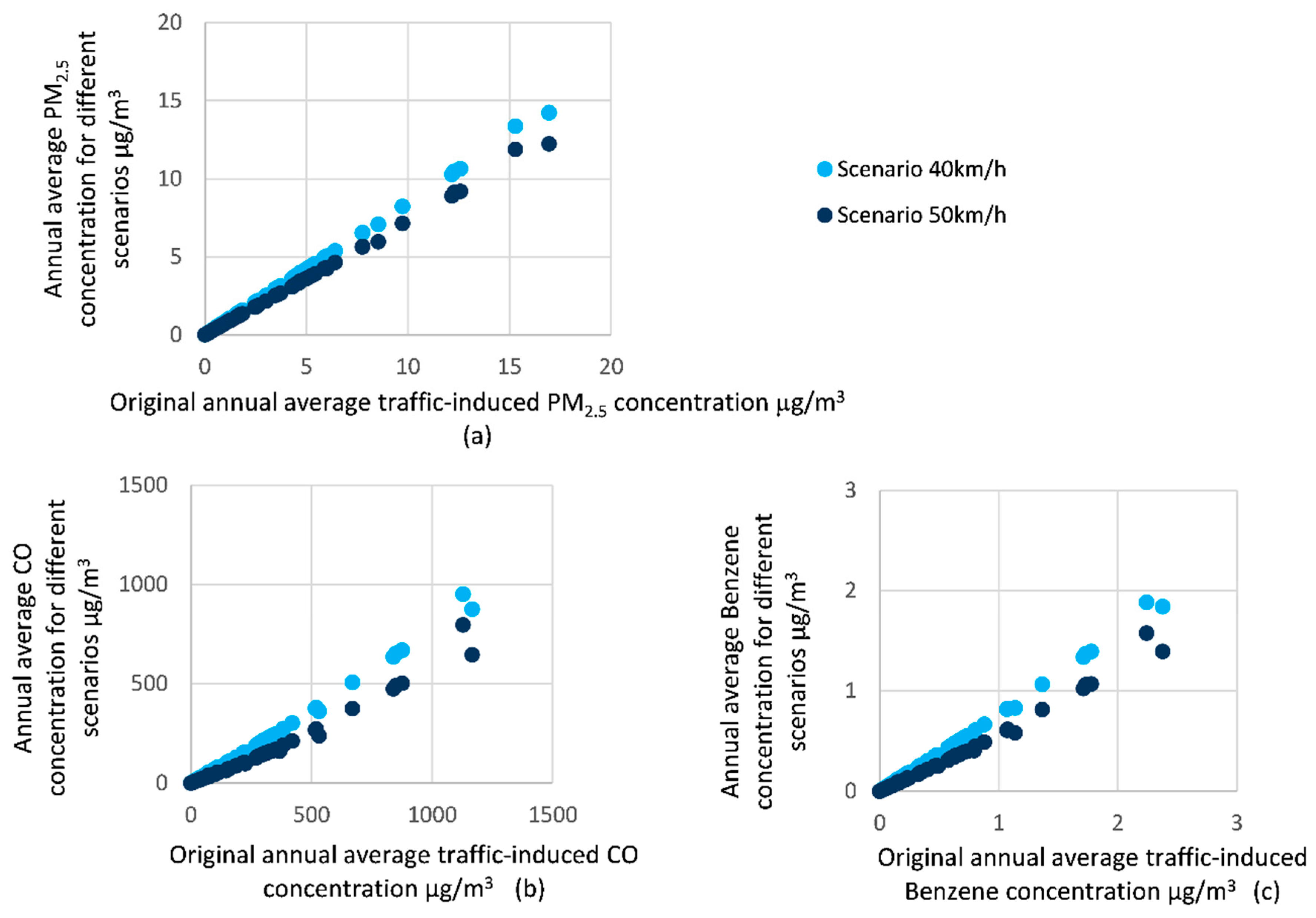
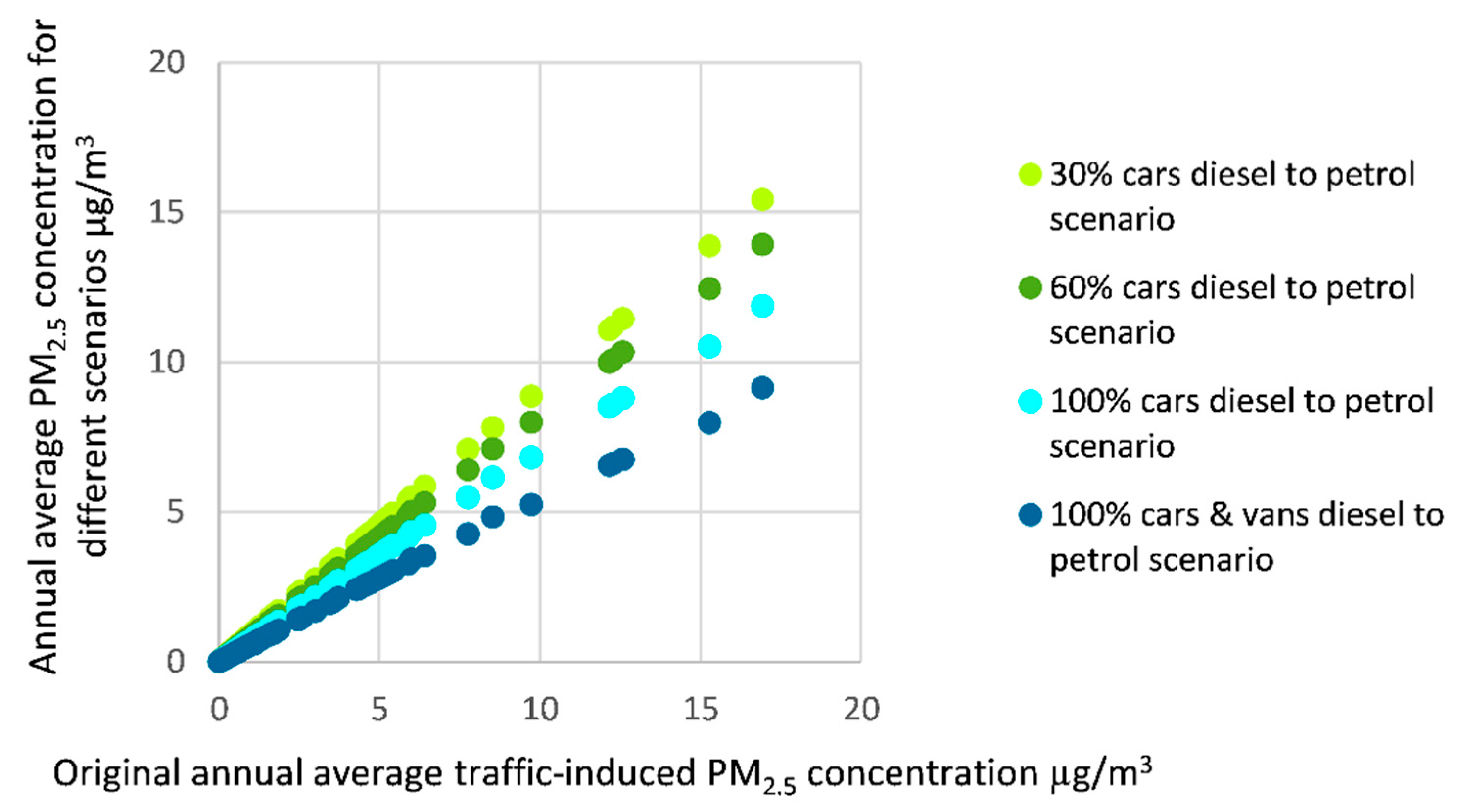
References
- Bowatte, G.; Lodge, C.J.; Knibbs, L.D.; Lowe, A.J.; Erbas, B.; Dennekamp, M.; Marks, G.B.; Giles, G.; Morrison, S.; Thompson, B.; et al. Traffic-related air pollution exposure is associated with allergic sensitization, asthma, and poor lung function in middle age. J. Allergy Clin. Immunol. 2017, 139, 122–129. [Google Scholar] [CrossRef] [PubMed]
- Chen, H.; Kwong, J.C.; Copes, R.; Hystad, P.; van Donkelaar, A.; Tu, K.; Brook, J.R.; Goldberg, M.S.; Martin, R.V.; Murray, B.J.; et al. Exposure to ambient air pollution and the incidence of dementia: A population-based cohort study. Environ. Int. 2017, 108, 271–277. [Google Scholar] [CrossRef] [PubMed]
- Estarlich, M.; Ballester, F.; Davdand, P.; Llop, S.; Esplugues, A.; Fernández-Somoano, A.; Lertxundi, A.; Guxens, M.; Basterrechea, M.; Tardón, A.; et al. Exposure to ambient air pollution during pregnancy and preterm birth: A Spanish multicenter birth cohort study. Environ. Res. 2016, 147, 50–58. [Google Scholar] [CrossRef] [PubMed]
- Raaschou-Nielsen, O.; Beelen, R.; Wang, M.; Hoek, G.; Andersen, Z.J.; Hoffmann, B.; Stafoggia, M.; Samoli, E.; Weinmayr, G.; Dimakopoulou, K.; et al. Particulate matter air pollution components and risk for lung cancer. Environ. Int. 2016, 87, 66–73. [Google Scholar] [CrossRef] [PubMed]
- Andersen, Z.J.; Raaschou-Nielsen, O.; Ketzel, M.; Jensen, S.S.; Hvidberg, M.; Loft, S.; Tjønneland, A.; Overvad, K.; Sørensen, M. Diabetes incidence and long-term exposure to air pollution: A cohort study. Diabetes Care 2012, 35, 92–98. [Google Scholar] [CrossRef] [PubMed]
- Health Effects Institute. Traffic-Related Air Pollution: A Critical Review of the Literature on Emissions, Exposure, and Health Effects; Health Effects Institute: Boston, MA, USA, 2010. [Google Scholar]
- Rosenlund, M.; Picciotto, S.; Forastiere, F.; Stafoggia, M.; Perucci, C.A. Traffic-Related Air Pollution in Relation to Incidence and Prognosis of Coronary Heart Disease. Epidemiology 2008, 19, 121–128. [Google Scholar] [CrossRef] [PubMed]
- Eze, I.C.; Schaffner, E.; Fischer, E.; Schikowski, T.; Adam, M.; Imboden, M.; Tsai, M.; Carballo, D.; von Eckardstein, A.; Künzli, N.; et al. Long-term air pollution exposure and diabetes in a population-based Swiss cohort. Environ. Int. 2014, 70, 95–105. [Google Scholar] [CrossRef] [PubMed]
- Raaschou-Nielsen, O.; Andersen, Z.J.; Beelen, R.; Samoli, E.; Stafoggia, M.; Weinmayr, G.; Hoffmann, B.; Fischer, P.; Nieuwenhuijsen, M.J.; Brunekreef, B.; et al. Air pollution and lung cancer incidence in 17 European cohorts: Prospective analyses from the European Study of Cohorts for Air Pollution Effects (ESCAPE). Lancet Oncol. 2013, 14, 813–822. [Google Scholar] [CrossRef]
- Llop, S.; Ballester, F.; Estarlich, M.; Esplugues, A.; Rebagliato, M.; Iñiguez, C. Preterm birth and exposure to air pollutants during pregnancy. Environ. Res. 2010, 110, 778–785. [Google Scholar] [CrossRef]
- Krämer, U.; Herder, C.; Sugiri, D.; Strassburger, K.; Schikowski, T.; Ranft, U.; Rathmann, W. Traffic-related air pollution and incident type 2 diabetes: Results from the SALIA cohort study. Environ. Health Perspect. 2010, 118, 1273–1279. [Google Scholar] [CrossRef]
- World Health Organization. Burden of Disease from Ambient Air Pollution for 2016; World Health Organization: Geneva, Switzerland, 2018. [Google Scholar]
- Landrigan, P.J.; Fuller, R.; Acosta, N.J.R.; Adeyi, O.; Arnold, R.; Basu, N.; Baldé, A.B.; Bertollini, R.; Bose-O’Reilly, S.; Boufford, J.I.; et al. The Lancet Commission on pollution and health. Lancet 2017, 391. [Google Scholar] [CrossRef]
- Bowatte, G.; Lodge, C.J.; Knibbs, L.D.; Erbas, B.; Perret, J.L.; Jalaludin, B.; Morgan, G.G.; Bui, D.S.; Giles, G.G.; Hamilton, G.S.; et al. Traffic related air pollution and development and persistence of asthma and low lung function. Environ. Int. 2018, 113, 170–176. [Google Scholar] [CrossRef]
- Calderón-Garcidueñas, L.; Leray, E.; Heydarpour, P.; Torres-Jardón, R.; Reis, J. Air pollution, a rising environmental risk factor for cognition, neuro inflammation and neurodegeneration: The clinical impact on children and beyond. Rev. Neurol. 2016, 172, 69–80. [Google Scholar] [CrossRef] [PubMed]
- Chiu, Y.-H.M.; Hsu, H.-H.L.; Coull, B.A.; Bellinger, D.C.; Kloog, I.; Schwartz, J.; Wright, R.O.; Wright, R.J. Prenatal particulate air pollution and neurodevelopment in urban children: Examining sensitive windows and sex-specific associations. Environ. Int. 2016, 87, 56–65. [Google Scholar] [CrossRef] [PubMed]
- Saenen, N.D.; Provost, E.B.; Viaene, M.K.; Vanpoucke, C.; Lefebvre, W.; Vrijens, K.; Roels, H.A.; Nawrot, T.S. Recent versus chronic exposure to particulate matter air pollution in association with neurobehavioral performance in a panel study of primary schoolchildren. Environ. Int. 2016, 95, 112–119. [Google Scholar] [CrossRef] [PubMed]
- Lee, C.; Kim, H.; Lim, Y.; Yang, J.; Yu, S.; Lee, J.; Chang, J.; Son, H.; Park, J.; Shin, D. Evaluation of the relationship between allergic diseases in school children at Seoul’s roadside elementary schools and air pollution. Atmos. Pollut. Res. 2015, 6, 1001–1012. [Google Scholar] [CrossRef]
- Flores-Pajot, M.-C.; Ofner, M.; Do, M.T.; Lavigne, E.; Villeneuve, P.J. Childhood autism spectrum disorders and exposure to nitrogen dioxide, and particulate matter air pollution: A review and meta-analysis. Environ. Res. 2016, 151, 763–776. [Google Scholar] [CrossRef] [PubMed]
- European Environment Agency (EEA). National Emissions Reported to the Convention on Long-Range Transboundary Air Pollution (LRTAP Convention); European Environmental Agency: Copenhagen, Denmark, 2012.
- Environmental Protection Agency. Ireland’s Informative Inventory Report 2017; Environmental Protection Agency: Washington, DC, USA, 2017.
- European Environment Agency. Air Pollution Fact Sheet 2014 Ireland; European Environment Agency: Copenhagen, Denmark, 2014.
- Bigazzi, A.Y.; Rouleau, M. Can traffic management strategies improve urban air quality? A review of the evidence. J. Transp. Heal. 2017, 7, 111–124. [Google Scholar] [CrossRef]
- Alam, M.S.; Hyde, B.; Duffy, P.; McNabola, A. Analysing the Co-Benefits of transport fleet and fuel policies in reducing PM 2.5 and CO2 emissions. J. Clean. Prod. 2018, 172, 623–634. [Google Scholar] [CrossRef]
- Tang, J.; McNabola, A.; Misstear, B.; Caulfield, B. An evaluation of the impact of the Dublin Port Tunnel and HGV management strategy on air pollution emissions. Transp. Res. Part D Transp. Environ. 2017, 52, 1–14. [Google Scholar] [CrossRef]
- Alam, M.S.; McNabola, A. A critical review and assessment of Eco-Driving policy & technology: Benefits & limitations. Transp. Policy 2014, 35, 42–49. [Google Scholar]
- Alam, M.S.; McNabola, A. Network-wide traffic and environmental impacts of acceleration and deceleration among Eco-Driving Vehicles in different road configurations. Transp. Plan. Technol. 2018, 41, 244–264. [Google Scholar] [CrossRef]
- Ghafghazi, G.; Hatzopoulou, M. Simulating the air quality impacts of traffic calming schemes in a dense urban neighborhood. Transp. Res. Part D Transp. Environ. 2015, 35, 11–22. [Google Scholar] [CrossRef]
- Jiang, W.; Boltze, M.; Groer, S.; Scheuvens, D. Impacts of low emission zones in Germany on air pollution levels. In Proceedings of the Transportation Research Procedia. Transp. Res. Procedia 2017, 25, 3374–3386. [Google Scholar] [CrossRef]
- Holman, C.; Harrison, R.; Querol, X. Review of the efficacy of low emission zones to improve urban air quality in European cities. Atmos. Environ. 2015, 111, 161–169. [Google Scholar] [CrossRef]
- EPA Other Metadata and Data Resources on SAFER. Available online: http://erc.epa.ie/safer/resourcelisting.jsp?oID=10136&username=R0 (accessed on 15 June 2018).
- PTV AG. VISUM 15 User Manual; PTV AG: Karlsruhe, Germany, 2015. [Google Scholar]
- Berkowicz, R.; Olesen, H.R.; Jensen, S.S. User’s Guide to WinOSPM: Operational Street Pollution Model; National Environmental Research Institute: Aarhus, Denmark, 2003. [Google Scholar]
- Kakosimos, K.E.; Hertel, O.; Ketzel, M.; Berkowicz, R. Operational Street Pollution Model (OSPM)—A review of performed application and validation studies, and future prospects. Environ. Chem. 2010, 7, 485. [Google Scholar] [CrossRef]
- Aquilina, N.; Micallef, A. Evaluation of the operational street pollution model using data from European cities. Environ. Monit. Assess. 2004, 95, 75–96. [Google Scholar] [CrossRef]
- UK DMRB. Design Manual for Roads and Bridges: Volume 12—Traffic Appraisal of Road Schemes; DMRB: Birmingham, UK, 1997. [Google Scholar]
- Duffy, P.; Hanley, E.; Black, K.; O’Brien, P.; Hyde, B.; Ponzi, J.; Alam, S. Ireland’s National Inventory Report; Environmental Protection Agency: Washington, DC, USA, 2015. [Google Scholar]
- European Parliament. Directive 2009/28/EC of the European Parliament and of the Council of 23 April 2009. Off. J. Eur. Union 2009, 140, 16–62. [Google Scholar]
- Heinen, M.; Murrin, C.; Daly, L.; O’Brien, J.; Heavey, P.; Kilroe, J.; O’Brien, M.; Scully, H.; Mulhern, L.-M.; Lynam, A.; et al. The Childhood Obesity Surveillance Initiative (COSI) in the Republic of Ireland: Findings from 2008, 2010 and 2012; Health Service Executive: Dublin, Ireland, 2014. [Google Scholar]
- Chambers, M.; Schmitt, R. Diesel-powered Passenger Cars and Light Trucks. Available online: https://www.rita.dot.gov/bts/sites/rita.dot.gov.bts/files/publications/bts_fact_sheets/oct_2015/html/entire.html (accessed on 15 January 2018).
- Knight, S.; Qureshi, M.; Cleverly, J.; Duvall, L.; Gavron, N.; Jones, J.; Malthouse, K. Driving Away from Diesel: Reducing Air Pollution from Diesel Vehicles; Environment Committee: London, UK, 2015. [Google Scholar]
- National Transport Authority. 2016 Quality Bus Corridor Monitoring Report—Dublin; National Transport Authority: Dublin, Ireland, 2016.
- Fallah-Shorshani, M.; Shekarrizfard, M.; Hatzopoulou, M. Integrating a street-canyon model with a regional Gaussian dispersion model for improved characterisation of near-road air pollution. Atmos. Environ. 2017, 153, 21–31. [Google Scholar] [CrossRef]
- Int Panis, L.; Beckx, C.; Broekx, S.; De Vlieger, I.; Schrooten, L.; Degraeuwe, B.; Pelkmans, L. PM, NOx and CO2 emission reductions from speed management policies in Europe. Transp. Policy 2011, 18, 32–37. [Google Scholar] [CrossRef]
- Carsten, O.; Lai, F.; Chorlton, K.; Goodman, P.; Carslaw, D.; Hess, S. Speed Limit Adherence and Its Effect on Road Safety and Climate Change—Final Report; University of Leeds: Leeds, UK, 2008. [Google Scholar]
- Madireddy, M.; De Coensel, B.; Can, A.; Degraeuwe, B.; Beusen, B.; De Vlieger, I.; Botteldooren, D. Assessment of the impact of speed limit reduction and traffic signal coordination on vehicle emissions using an integrated approach. Transp. Res. Part D Transp. Environ. 2011, 16, 504–508. [Google Scholar] [CrossRef]
- Road Safety Authority. A Review of 2015 Fatal Collision Statistics as of 31 December 2015; Road Safety Authority: Ballina, Ireland, 2015.
- Environmental Protection Agency. Air Quality in Ireland 2016; Environmental Protection Agency: Washington, DC, USA, 2016.
- National Research Council (U.S.); Transportation Research Board; Committee for Guidance on Setting and Enforcing Speed Limits. Managing Speed: Review of Current Practice for Setting and Enforcing Speed Limits; National Academy Press: Washington, DC, USA, 1998; ISBN 0-309-06502-X. [Google Scholar]
- Cames, M.; Helmers, E. Critical evaluation of the European diesel car boom—Global comparison, environmental effects and various national strategies. Environ. Sci. Eur. 2013, 25, 15. [Google Scholar] [CrossRef]
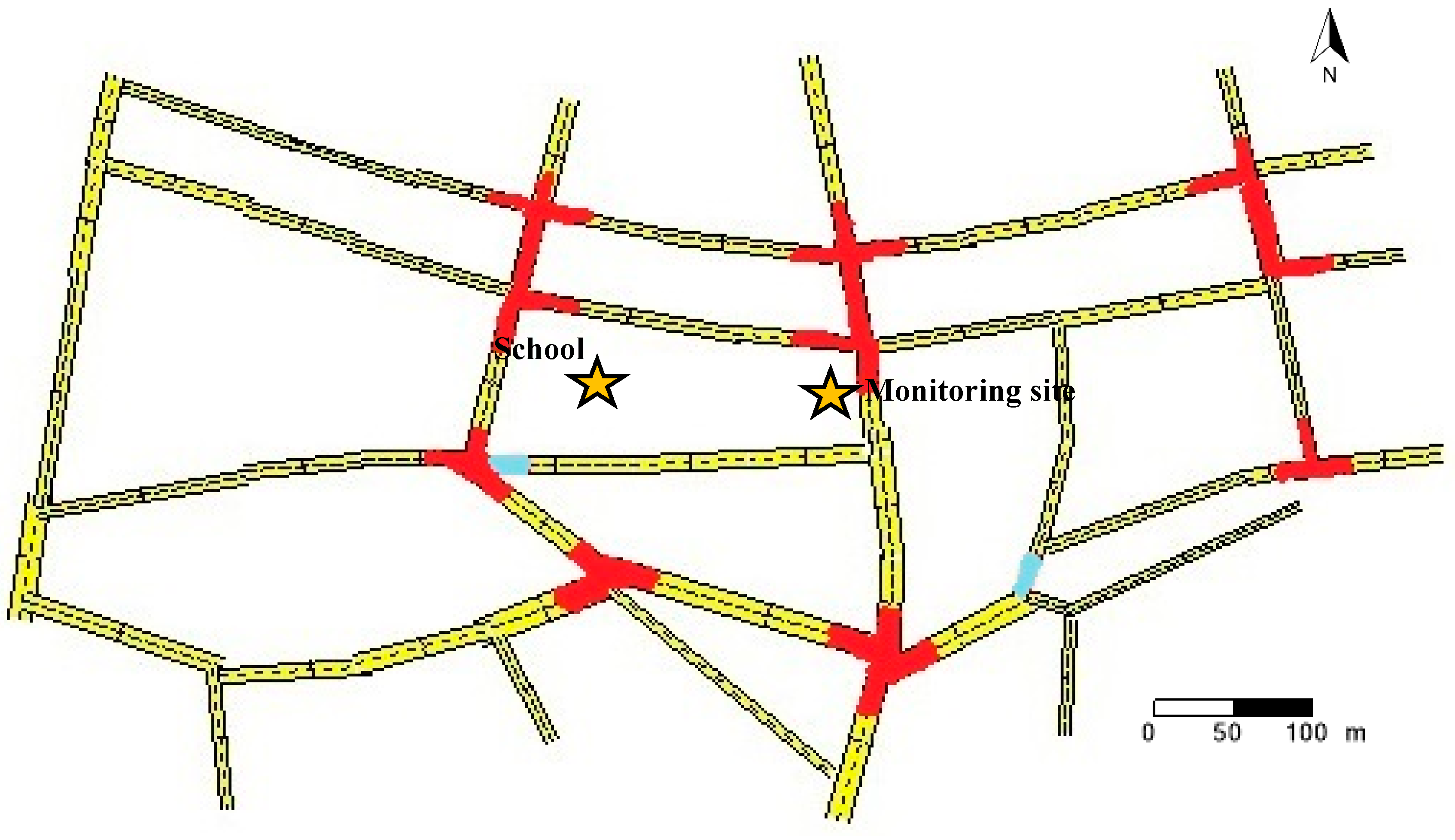
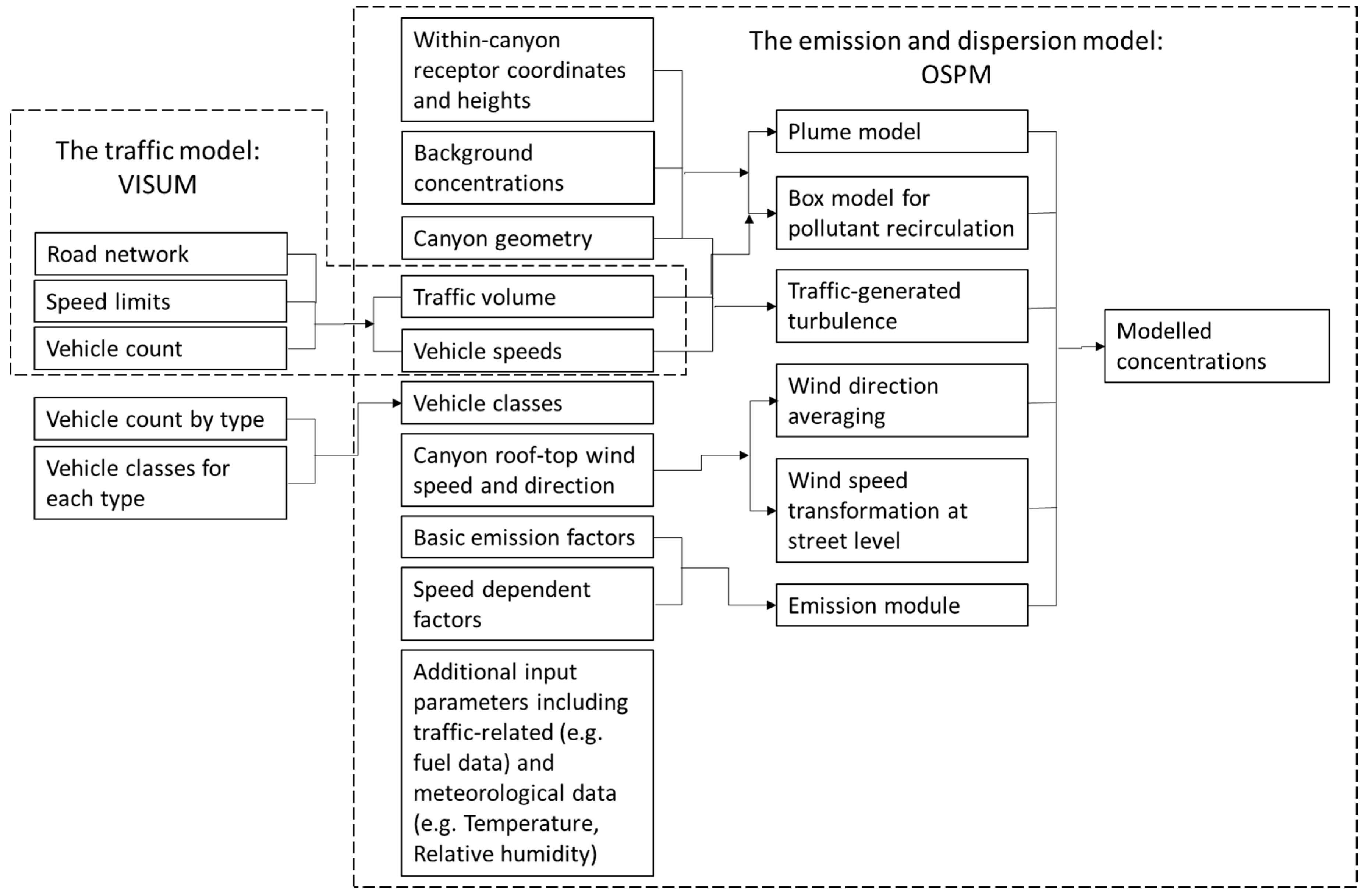
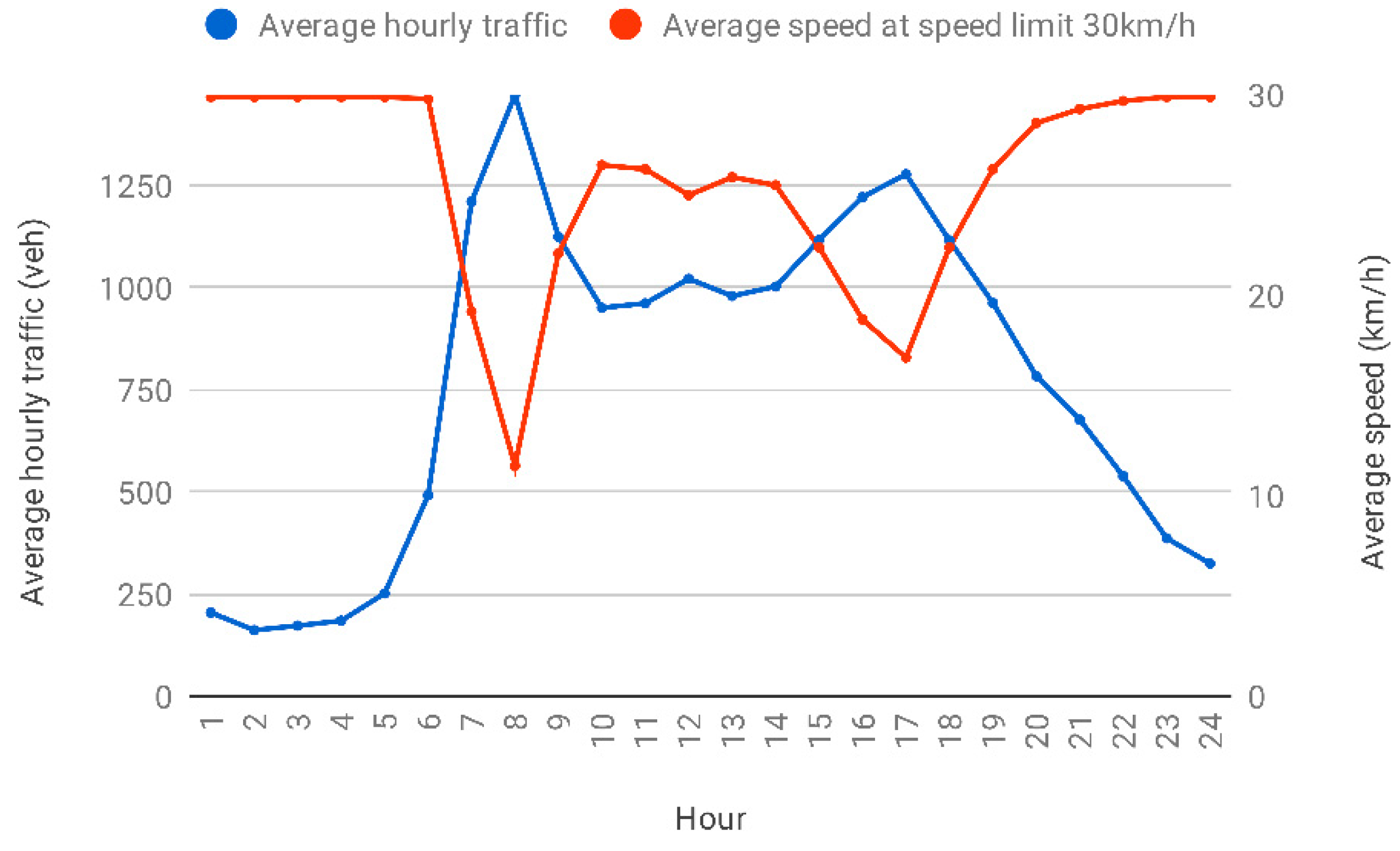
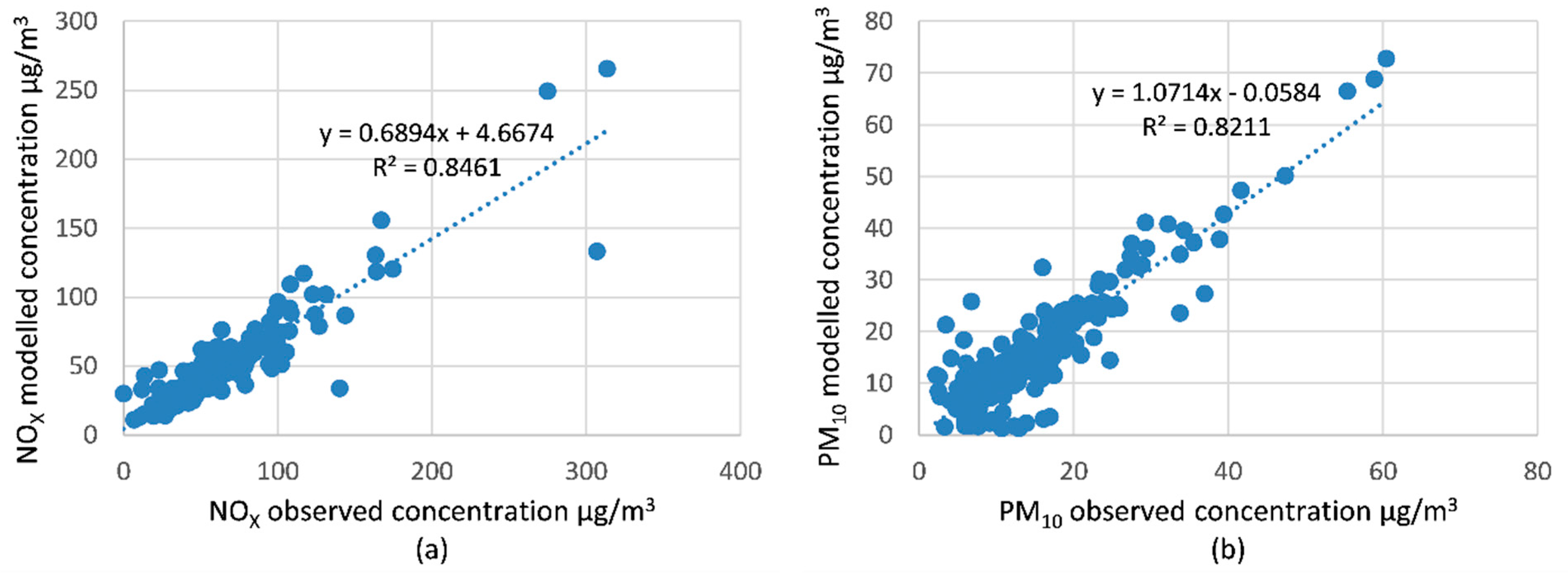
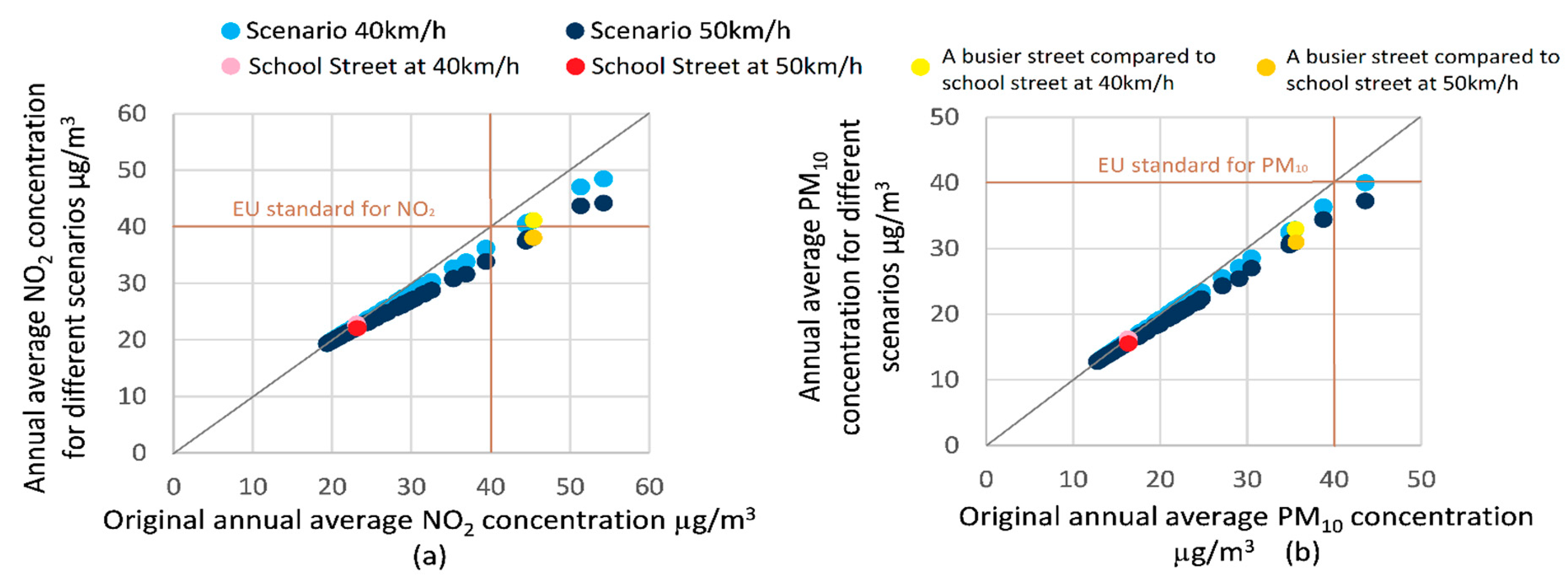
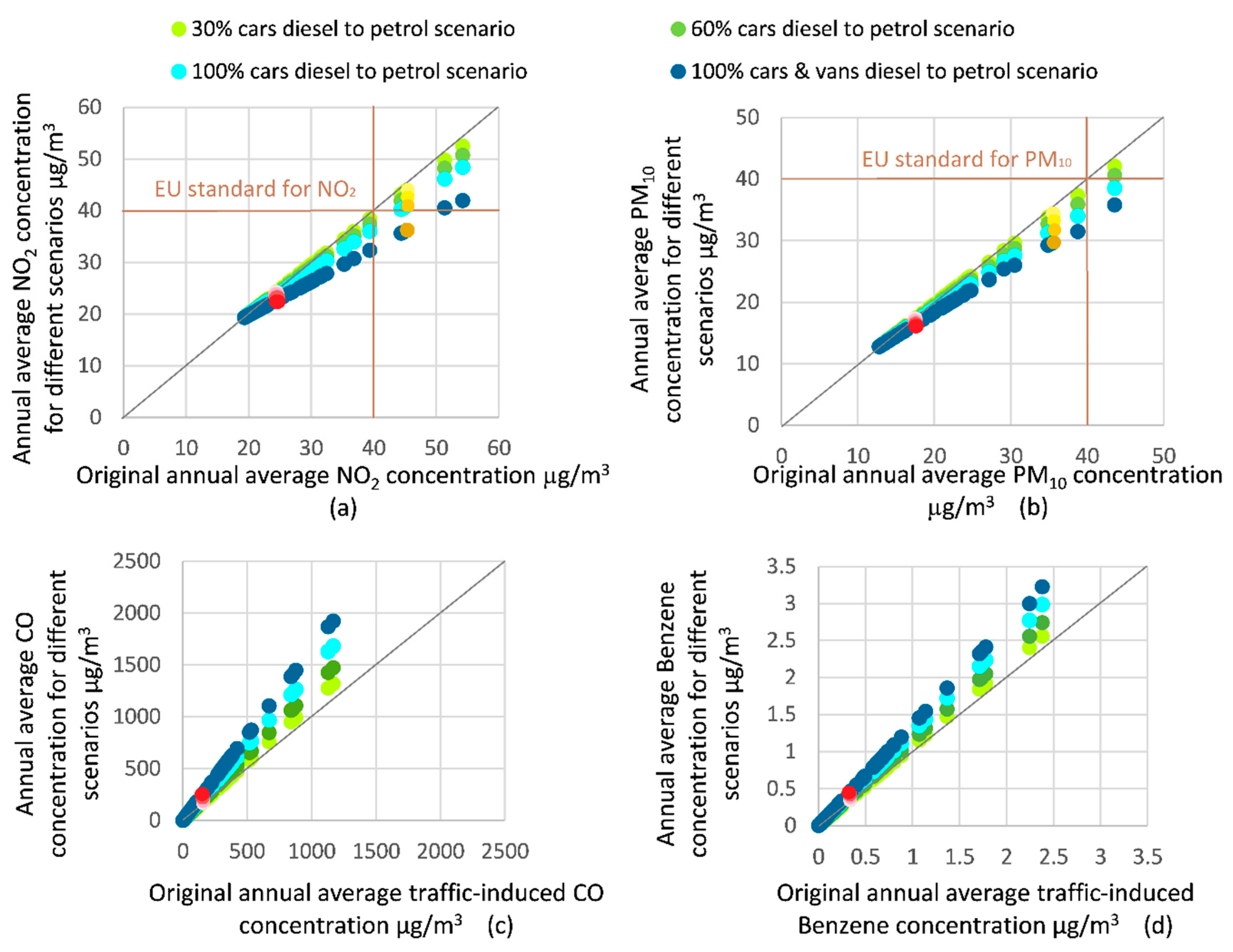
| Measure | Criteria | Guideline |
|---|---|---|
| GEH < 5 | >85% of cases |
| Category | % of Fleet | Fuel Type | Percentage in Each Category by Scenario (with Scenario Number Shown in Table 4) | ||||
|---|---|---|---|---|---|---|---|
| Baseline | 30% Diesel Cars to Petrol (iv) | 60% Diesel Cars to Petrol (v) | 100% Diesel Cars to Petrol (vi) | 100% Diesel Cars and Vans to Petrol (vii) | |||
| Passenger car | 82% | Petrol | 63% | 74% | 85% | 100% | 100% |
| Diesel | 37% | 26% | 15% | 0% | 0% | ||
| Van | 12% | Petrol | 0.30% | 0.30% | 0.30% | 0.30% | 100.00% |
| Diesel | 99.70% | 99.70% | 99.70% | 99.70% | 0% | ||
| Truck | 1% | Petrol | 0 | 0 | 0 | 0 | 0 |
| Diesel | 100% | 100% | 100% | 100% | 100% | ||
| Bus | 5% | Petrol | 0 | 0 | 0 | 0 | 0 |
| Diesel | 100% | 100% | 100% | 100% | 100% | ||
| Input Type | Element | Descriptive Statistics | Notes | |
|---|---|---|---|---|
| Mean | Standard Deviation | |||
| Background concentration | PM10 | 13.58 µg/m3 | 9.43 | Data source: PM10 monitoring site located at inner suburb in Dublin |
| NOX | 28.06 µg/m3 | 38.37 | Data source: NOX monitoring site located at a park in Dublin | |
| Building geometry | Building height/road width (H/W) | 0.98 | 0.41 | Data source: Google Maps |
| Weather condition | Wind speed | 5.63 m/s | 2.86 | Data source: the Irish meteorological service. Wind direction: Prevailing winds are westerly and south-westerly winds |
| Temperature | 9.52 °C | 5.46 | ||
| Relative humidity | 0.82 | 0.12 | ||
| Scenario Type | Scenario | Notes |
|---|---|---|
| Baseline |
| Reflection of the actual condition of 2013 |
| Speed limit |
| Baseline fleet composition was applied; speed limit was changed for these scenarios. |
| Fleet composition |
| 30 km/h speed limit was applied; detailed percentages of petrol and diesel vehicles for these scenarios are shown in Table 2 with the scenario number corresponding to each scenario number in this table. |
| Validation | # of Links and Turns | # of Hours | # of Cases | # of Cases with GEH <5 | % of Cases with GEH <5 |
|---|---|---|---|---|---|
| 2 | 600 | 1200 | 1041 | 87% |
| Scenarios | Street in Front of the School | A Street with High Original Concentration | |
|---|---|---|---|
| Original concentration | NO2 | 22 µg/m3 | 45 µg/m3 |
| PM10 | 14 µg/m3 | 35 µg/m3 | |
| Concentration with 30% diesel changing to petrol cars (change in traffic-induced concentration) | NO2 | −1% (−5%) | −3% (−5%) |
| PM10 | −1% (−4%) | −3% (−5%) | |
| Concentration with 60% diesel changing to petrol cars (change in traffic-induced concentration) | NO2 | −2% (−10%) | −6% (−10%) |
| PM10 | −1% (−8%) | −6% (−10%) | |
| Concentration with 100% diesel changing to petrol cars (change in traffic-induced concentration) | NO2 | −2% (−16%) | −9% (−17%) |
| PM10 | −2% (−14%) | −11% (−17%) | |
| Concentration with 100% diesel changing to petrol cars and vans (change in traffic-induced concentration) | NO2 | −4% (−35%) | −20% (−35%) |
| PM10 | −3% (−22%) | −16% (−26%) |
© 2019 by the authors. Licensee MDPI, Basel, Switzerland. This article is an open access article distributed under the terms and conditions of the Creative Commons Attribution (CC BY) license (http://creativecommons.org/licenses/by/4.0/).
Share and Cite
Tang, J.; McNabola, A.; Misstear, B.; Pilla, F.; Alam, M.S. Assessing the Impact of Vehicle Speed Limits and Fleet Composition on Air Quality Near a School. Int. J. Environ. Res. Public Health 2019, 16, 149. https://doi.org/10.3390/ijerph16010149
Tang J, McNabola A, Misstear B, Pilla F, Alam MS. Assessing the Impact of Vehicle Speed Limits and Fleet Composition on Air Quality Near a School. International Journal of Environmental Research and Public Health. 2019; 16(1):149. https://doi.org/10.3390/ijerph16010149
Chicago/Turabian StyleTang, Jiayi, Aonghus McNabola, Bruce Misstear, Francesco Pilla, and Md Saniul Alam. 2019. "Assessing the Impact of Vehicle Speed Limits and Fleet Composition on Air Quality Near a School" International Journal of Environmental Research and Public Health 16, no. 1: 149. https://doi.org/10.3390/ijerph16010149
APA StyleTang, J., McNabola, A., Misstear, B., Pilla, F., & Alam, M. S. (2019). Assessing the Impact of Vehicle Speed Limits and Fleet Composition on Air Quality Near a School. International Journal of Environmental Research and Public Health, 16(1), 149. https://doi.org/10.3390/ijerph16010149







